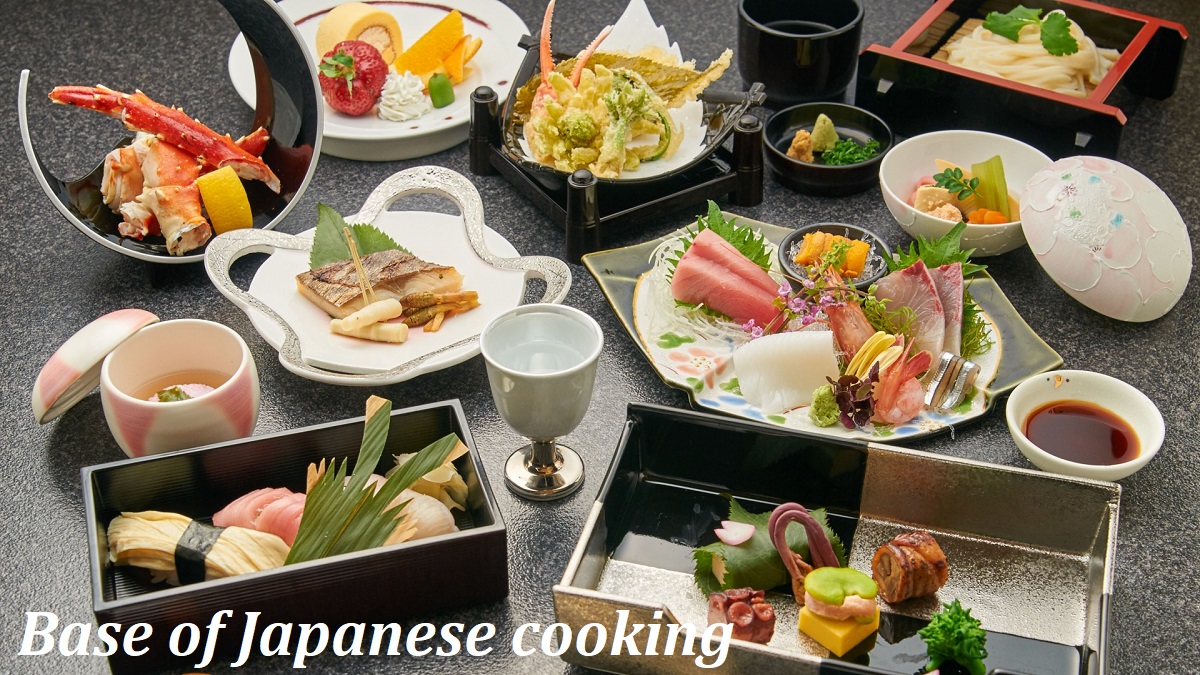Base of Japanese cooking
Basic Seasonings
Dashi
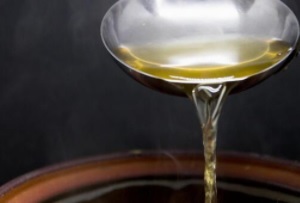
Dashi is the soup stock for Japanese cooking.
Almost Japanese dishes are made with this.
It is the most important element of the flavor.
Dashi is commonly made by boiling a piece of "konbu" and shavings of "katsuobushi" in a pot of water and straining the liquid.
Konbu is an edible kelp and it is gathered around the coast of Hokkaido and north Tohoku regions.
A piece of dried konbu is used to make dashi.
Light flavor comes out from the inside of konbu.
Katsuobushi is the dried, fermented, and smoked flesh of bonito.
Bonito is a kind of migratory fish and is called as "katsuo" in Japanese.
Katsuobushi is very hard block.
A handful of flakes shaved with a tool like plane are used.
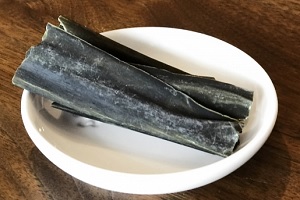
Dried Konbu
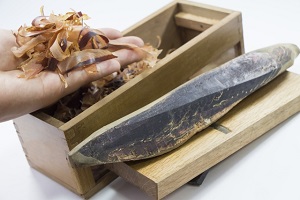
Shaved katsuobushi
Sometimes, dried shiitake mashroom is added to konbu and katsuobushi.
Shiitake is a popular mashroom eaten mainly in eastern Asia.
Instead of katsuobushi, other dried small fish such as sardine, Japanese anchovy, flying fish, etc. are sometimes used.
These are called Niboshi or Iriko, and it is common people's taste because they are cheap.
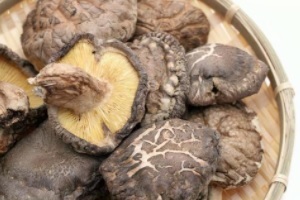
Dried Shiitake
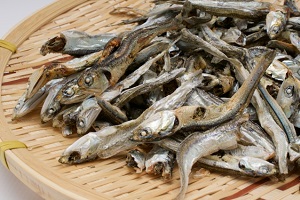
Niboshi (Dried Anchovy)
Completed dashi is a little yellowish liquid.
The main flavor is from the bonito or the other fish and savoriness from konbu and shiitake is added.
But it has never a fishy smell.
This is exactly Japanese flavor.
But recently, many Japanese people use industrially-produced instant dashi at home because of saving the trouble of making genuine dashi.
Shoyu (Soy sauce)
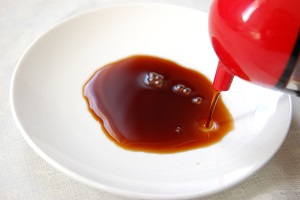
Shoyu is one of the most important seasonings of Japanese cooking.
It is made by boiling soy beans, fermenting them after adding salt water, and pressing out.
Therefore, it is translated as "soy sauce" in English.
It is dark brown liquid, and has salty taste and mild flavor.
Of course, shoyu is produced by manufacturer.
It is impossible to make shoyu at home.
Basic soup for Japanese dish are made by mixing shoyu to dashi.
And, shoyu is often directly used as a sauce.
There are many shoyu makers in Japan, and they make the shoyu which is liked by the regional people.
The big makers are Kikkoman, Yamasa, Higeta, Higashimaru and Marukin Chuyu.
Kikkoman is well-known in the world.
Miso
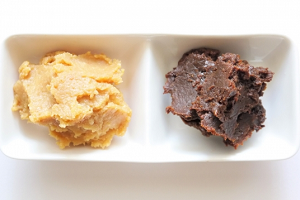
Shiro-miso (left), Aka-miso (right)
Miso is also one of the most important seasonings of Japanese cooking.
It is brown salty paste.
It is made by boiling soy beans, fermenting them after adding grain and salt.
Usually rice or wheat are mixed to soy beans.
According to the difference of the maturing period and the salinity concentration, there are two types of miso.
One type is called shiro-miso.
The translated word is "white-miso", but the color is light brown.
The taste is mild.
Another type is called aka-miso.
The translated word is "red-miso", but the color is dark-brown.
The taste is thick and a little salty.
Miso is mainly used to make "miso soup".
And, it is used as seasoning for various foods.
In addition, fish or meat pickled in this miso keeps for a long time and gets tasty.
There are many miso makers around Japan, but they has stronger locality than shoyu.
Mirin
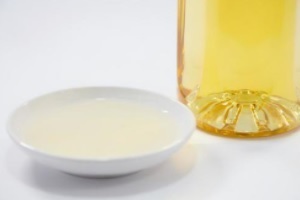
Mirin is a kind of rice wine similar to sake for cooking.
It contains 40% to 50% sugar and 10% to 14% alcohol.
It is yellow liquid and tastes sweet.
Mirin adds sweet taste to the cooking foods.
The delicate sweet taste is a feature of Japanese cuisine.
Mirin is also used to add a bright touch to grilled fish or meat, or to erase the fishy smell.
Other main seasonings
In Japanese cooking, sugar, salt, vinegar and sake are used except above seasonings.
Sugar is often used to sweeten cooking foods.
It is added to the soup of dashi and shoyu in various Japanese dishes, so you may feel that Japanese dishes have salty-sweet taste.
Salt, of course, makes the dish saltier.
It is used instead of shoyu when the cook want to keep the dish clear. (Shoyu is enough salty.)
Vinegar is mainly used to make "sushi" or "sunomono" (vinegared dish).
Sake is rice wine.
Of cource, we drink it, but it is used to erase the fishy smell like mirin in cooking.
Making the most basic soup to cook
Basic Japanese soup = Dashi + Shoyu + (Sake + Sugar)
To cook Japanese dish, learn above formula.
According to the dish, you have only to change the ratio of each seasoning.
You can replace (Sake + Sugar) with Mirin.
To adjust to suit your taste, it is possible to add a little salt or a few spoons of miso.
For example,...
Soup for boiled dish = Dashi 10 + Shoyu 1 + Mirin 1
Soup for Donburi dish = Dashi 4 + Shoyu 1 + Mirin 1
Teriyaki sauce = Dashi 0 + Shoyu 1 + Sugar 1
Soup for Udon noodle = Dashi 14 + Shoyu 1 + Mirin 1
Miso-soup = Dashi 10 + Shoyu 0 + Mirin 0 + Miso 1
Spices for Japanese cuisene
Black pepper and garlic are used to flavor in the cuisine of many countries.
But, these are hardly used when Japanese dishes are cooked.
Instead of them, the following spices are used.
Ginger
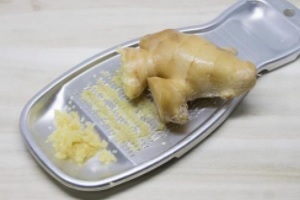
Ginger is often used as the spice of cooking in Japan and China.
In Japanese cooking, ginger is used by grating or slicing.
It adds strong flavor to the dish, or removes the smell of fish and meat.
The pickles of sliced ginger is always served when you eat sushi.
Dried red pepper
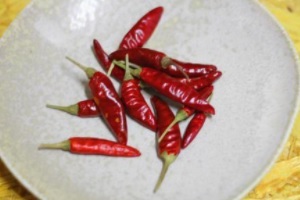
Dried red pepper is sometimes used in Japanese cooking.
Many dishes in Asian countries are very hot by peppers.
But, in Japanese cooking, red pepper is used for adding a slightly sharp taste to the dish.
Rather, the eater can often add the taste of red pepper to the dish at the table.
For the purpose, two types of small spice bottle are sold.
One is "Shichimi-togarashi".
"Shichimi" means "seven tastes" and "togarashi" means "red pepper".
The spice includes the powder of red pepper, sesame seed, roasted orange peel, poppy seed, and a few kind of spices.
Another is "Ichimi-togarashi".
"Ichimi" means "one taste", and it is only the powder of red pepper.
These are used by sprinkling on the dish according to your tastes.
Main dishes to do so are Japanese noodles (udon, soba), gyudon, yakitori, etc.
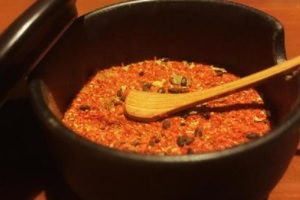
Shichimi
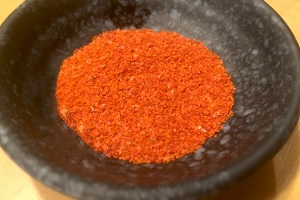
Ichimi
Wasabi
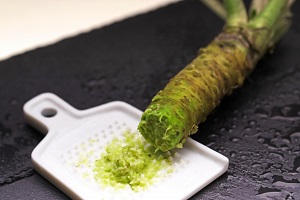
Wasabi is translated as "Japanese horseradish" in English.
The plants are cultivated in the stream of clear water in the mountain.
It is used by grating the root.
The color is light green, and the taste stimulates your nose strongly for some seconds.
Wasabi is indispensable to sushi and sashimi.
Karashi

Karashi on Tonkatsu dish
Karashi is Japanese mustard.
It is served as yellow paste, and the hot flavor irritates the nose.
It is different from Western musterd.
The seeds of the herb called "Oriental mustard" are powdered, then that is kneaded with water.
Karashi is served as a spice on the dish of Tonkatsu, Oden, and some various dishes.
Sansho & Kinome
Sansho is translated as "Japanese pepper" in English.
It is a citrus shrub, and bears a lot of very small fruits.
The unripe fruits in summer are used as an ingredient.
Ripe fruits in autumn are processed, and the powder is used as a spice called "Sansho".
It is spicy, but it has a uniquely fresh scent.
This is indispensable for the dish of broiled eel.
Young leaves sprout in spring, and the leaves with the fresh scent are edible.
It is called "Kinome", and a piece is put on spring dish as a symbol and spice of spring.

Fruits of Sansho

Kinome on the dish

